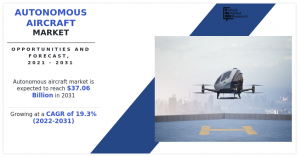
Autonomous Aircraft Market Worth $37.06 Billion by 2030 – AMR
WILMINGTON, DELAWARE, UNITED STATES, September 27, 2023 /EINPresswire.com/ — Autonomous aircraft can be identified by their capability to execute intricate maneuvers over prolonged periods and at significant distances from a remote location. The incorporation of autonomous systems into an aircraft alleviates the pilot’s workload. The autopilot is responsible for maintaining the aircraft on a predetermined course at cruising altitudes, and it can execute climbs, descents, and turns as directed. Consequently, the speed and dependability of fully autonomous systems positions them as superior to humans in managing urban skies characterized by numerous obstacles.
The growth of the global autonomous aircraft market is propelled by various factors, including the increasing adoption of autonomous cargo aircraft, a surge in the implementation of autonomy to minimize human errors, and the rising use of artificial intelligence in autonomous aircraft.
𝐏𝐫𝐨𝐜𝐮𝐫𝐞 𝐂𝐨𝐦𝐩𝐥𝐞𝐭𝐞 𝐑𝐞𝐬𝐞𝐚𝐫𝐜𝐡 𝐑𝐞𝐩𝐨𝐫𝐭- https://www.alliedmarketresearch.com/autonomous-aircraft-market/purchase-options
𝐓𝐡𝐞 𝐠𝐥𝐨𝐛𝐚𝐥 𝐚𝐮𝐭𝐨𝐧𝐨𝐦𝐨𝐮𝐬 𝐚𝐢𝐫𝐜𝐫𝐚𝐟𝐭 𝐢𝐧𝐝𝐮𝐬𝐭𝐫𝐲: 𝐮𝐩𝐜𝐨𝐦𝐢𝐧𝐠 𝐭𝐫𝐞𝐧𝐝𝐬
𝑼𝒕𝒊𝒍𝒊𝒛𝒂𝒕𝒊𝒐𝒏 𝒐𝒇 𝒂𝒅𝒗𝒂𝒏𝒄𝒆𝒅 𝒓𝒂𝒘 𝒎𝒂𝒕𝒆𝒓𝒊𝒂𝒍𝒔:
Advanced materials like composites and ceramics are increasingly employed in aircraft design to enhance performance and decrease weight. These materials provide advantages such as heightened fuel efficiency, enhanced durability, and reduced maintenance expenses. As technology progresses, we will probably witness the ongoing development of new materials for integration into aircraft design.
𝑰𝒏𝒄𝒐𝒓𝒑𝒐𝒓𝒂𝒕𝒊𝒐𝒏 𝒐𝒇 𝑪𝒍𝒐𝒖𝒅 𝒄𝒐𝒎𝒑𝒖𝒕𝒊𝒏𝒈:
Cloud computing has the potential to enhance the efficiency of airline operations by granting access to real-time data and analysis. Cloud-based systems find application in tasks such as flight planning, crew scheduling, and various other operational activities. By enabling data access from virtually anywhere, cloud computing can bolster collaboration and decision-making throughout the autonomous aircraft industry.
𝑰𝒏𝒗𝒐𝒍𝒗𝒆𝒎𝒆𝒏𝒕 𝒐𝒇 𝒑𝒓𝒆𝒅𝒊𝒄𝒕𝒊𝒗𝒆 𝒎𝒂𝒊𝒏𝒕𝒆𝒏𝒂𝒏𝒄𝒆:
Predictive maintenance is a methodology that harnesses data analysis and machine learning algorithms to anticipate equipment failures before they occur. In the aviation sector, this technology holds the potential to enhance aircraft maintenance practices and minimize operational downtime. By scrutinizing data obtained from sensors and various sources, predictive maintenance systems can identify potential issues and proactively inform maintenance crews, thereby averting breakdowns.
𝑹𝒆𝒗𝒐𝒍𝒖𝒕𝒊𝒐𝒏𝒂𝒓𝒚 3𝑫 𝒑𝒓𝒊𝒏𝒕𝒊𝒏𝒈:
3D printing technology can manufacture spare parts and components for aircraft, leading to both the time and cost reduction associated with maintenance. Additionally, it serves as a valuable tool for generating prototypes and models, enabling designers to experiment with novel concepts and enhance aircraft performance.
𝐑𝐞𝐪𝐮𝐞𝐬𝐭 𝐒𝐚𝐦𝐩𝐥𝐞 𝐏𝐚𝐠𝐞𝐬- https://www.alliedmarketresearch.com/request-sample/7486
𝐏𝐚𝐥𝐦𝐞𝐫 𝐋𝐮𝐜𝐤𝐞𝐲, 𝐭𝐡𝐞 𝐟𝐨𝐮𝐧𝐝𝐞𝐫 𝐨𝐟 𝐎𝐜𝐮𝐥𝐮𝐬, 𝐯𝐞𝐧𝐭𝐮𝐫𝐞𝐝 𝐢𝐧𝐭𝐨 𝐭𝐡𝐞 𝐰𝐨𝐫𝐥𝐝 𝐨𝐟 𝐡𝐢𝐠𝐡-𝐬𝐩𝐞𝐞𝐝 𝐚𝐮𝐭𝐨𝐧𝐨𝐦𝐨𝐮𝐬 𝐚𝐢𝐫𝐜𝐫𝐚𝐟𝐭.
Palmer Luckey, the founder of the Oculus virtual reality headset and known for his support of Donald Trump, is now venturing into the sector of autonomous military aircraft. On 7 September 2023, Thursday, Luckey’s venture-funded military technology company, Anduril, unveiled its latest creation: an AI-enabled autonomous aircraft with a fighter-jet-like appearance, named “Fury.” Anduril intends to seamlessly integrate Fury into its “Lattice” AI surveillance system, presently in use at the US border as a virtual wall. This announcement from Anduril coincides with a renewed effort by the US Department of Defense to procure cost-effective AI systems on a large scale.
The Fury aircraft originated from another company named Blue Force Technologies, and Anduril recently completed its acquisition on Thursday for an undisclosed sum. Anduril classifies Fury as a group-5 level (the highest level) autonomous aircraft, boasting “fighter-like performance.” The aircraft, with the capability to achieve speeds exceeding 700 miles per hour, can be updated with a diverse array of sensors and payloads, adaptable to specific mission demands. With these features, Fury could potentially serve in both surveillance and combat roles.
𝐌𝐚𝐤𝐞 𝐚𝐧 𝐈𝐧𝐪𝐮𝐢𝐫𝐲 𝐁𝐞𝐟𝐨𝐫𝐞 𝐁𝐮𝐲𝐢𝐧𝐠- https://www.alliedmarketresearch.com/purchase-enquiry/7486
David Correa
Allied Analytics LLP
+1 800-792-5285
email us here
Visit us on social media:
Facebook
Twitter
LinkedIn
![]()






































